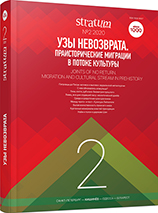Миграции и диффузии в неолитизации Поволжья
Migration and Diffusion in the Neolithization of Volga Region
Author(s): Konstantin Andreev, Aleksandr A. VybornovSubject(s): History, Archaeology, Cultural history, Migration Studies
Published by: Издательский дом Stratum, Университет «Высшая антропологическая школа»
Keywords: Eastern Europe; Volga region; Early Neolithic; neolithization; Elshanka culture; migration; diffusion;chronology;
Summary/Abstract: The problem of neolithization of certain regions in Eastern Europe is of current interest in modern Neolithic studies. The first ceramics in the Volga region appears at the beginning of the 7th millennium BC. Representatives of the Kelteminar culture (Central Asia) took an active part in the process of Neolithization in the forest-steppe Volga region and, as a result of migration, entered the region. Favorable climate conditions at the beginning of the Atlantic period contributed to the intensification of contacts. At the end of 7th — beginning of 6th millennium BC, Elshanka culture representatives contributed to the neolithization of many neighboring regions — Primokshan, Posuria, Volga forest, Don forest-steppe, Kama and some other regions. It is highly likely that diffusion of the early Neolithic population of the forest-steppe Volga region to adjacent regions was associated with aridization of the climate at the end of the 7th millennium BC. The oldest ceramics of these territories show significant typological similarities with Elshanka materials. At the same time, neolithization of the semi-desert Volga region could be associated with the processes of self-development of the indigenous population and insignificant diffusion of foreign cultures that contributed to the start of ceramic production in the region.
Journal: Stratum plus. Археология и культурная антропология
- Issue Year: 2020
- Issue No: 2
- Page Range: 15-30
- Page Count: 16
- Language: Russian
- Content File-PDF

